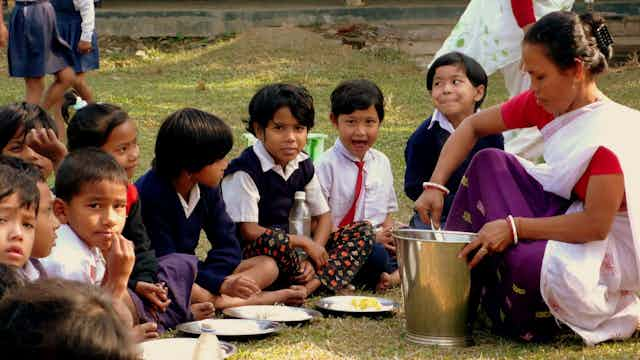In the aftermath of the death of 22 schoolchildren in the state of Bihar in India, the Mid Day Meal (MDM) scheme, which provides free school lunches to more than 120 million children, has attracted widespread criticism. It has been described as a “deadly state-run charity”. Attention has tended to focus on past stories of illness, corruption and scandal. However, these reactions obscure the sheer scale of the scheme and the progress it has made.
The National Programme of Nutritional Support to Primary Education (NP-NSPE), commonly know as the MDM Scheme, was launched in 1995, but has roots in Chennai as far back as 1925. As a centrally sponsored scheme run by the Government of India, it provides cooked and nutritious food of a minimum of 300 calories to primary and secondary school children.
This scheme is by far the largest nutrition programme in the world. To run it on such a scale, considering the vast quantities of food, fuel and infrastructure required to supply more than a million schools is in itself is a success story.
All children in the first eight years of state-run schools education are provided with free meals. This regular source of supplementary nutrition for children has improved nutritional status of these children. There are children from poor socio-economic backgrounds who would not even receive a meal a day were it not for this scheme. Studies have shown reductions in skin infection and anaemia, and marked improvements in body mass index as a result.
As well as combating malnutrition, the programme has encouraged school attendance, ensuring that what children are fed has direct effects on their learning capabilities, as they are able to concentrate better. Numerous studies have demonstrated this direct correlation between the lunch program and increased student enrolment, attendance, attention spans and exam scores.
The meals also provide opportunities in health education. Children are taught about washing their hands before and after eating and about the importance of clean water and good hygiene.
Social equality is also promoted as children from various social backgrounds all receive and share a common meal. The scheme can therefore help to break the barriers of caste and class among schoolchildren. This is also relevant in when it comes to gender equality, as the meal helps to remove the barriers that prevent girls from going to school by providing all children with the same meal. Child labour practice can also be minimised if children come to school regularly. This alone allows a significant amount of inequality to be addressed.
The scheme also necessitates widespread employment for women, which enables enhancement of their economic freedom.
All this is not to say that the scheme does not need improvement. But to label a scheme “deadly” because of one event would be incredibly short-sighted. We should use the tragic event of last week as an opportunity to improve it.
What can be done
More strict and continuous evaluation should be a matter of course. Spot inspections of schools should be held to check the quality as well as the quantity of food served, and food samples should be analysed to check their nutritional content.
The private sector should be involved in the MDM scheme in order to promote its effective and efficient functionality. A training programme for cooks should be implemented, and nutritionists could be appointed to oversee its operation at district level.
We all should be more attentive and dedicated so that further incidents don’t occur in the future, but this sad event should not cloud the vast nutritional, educational and social improvements that the MDM scheme has already achieved.


